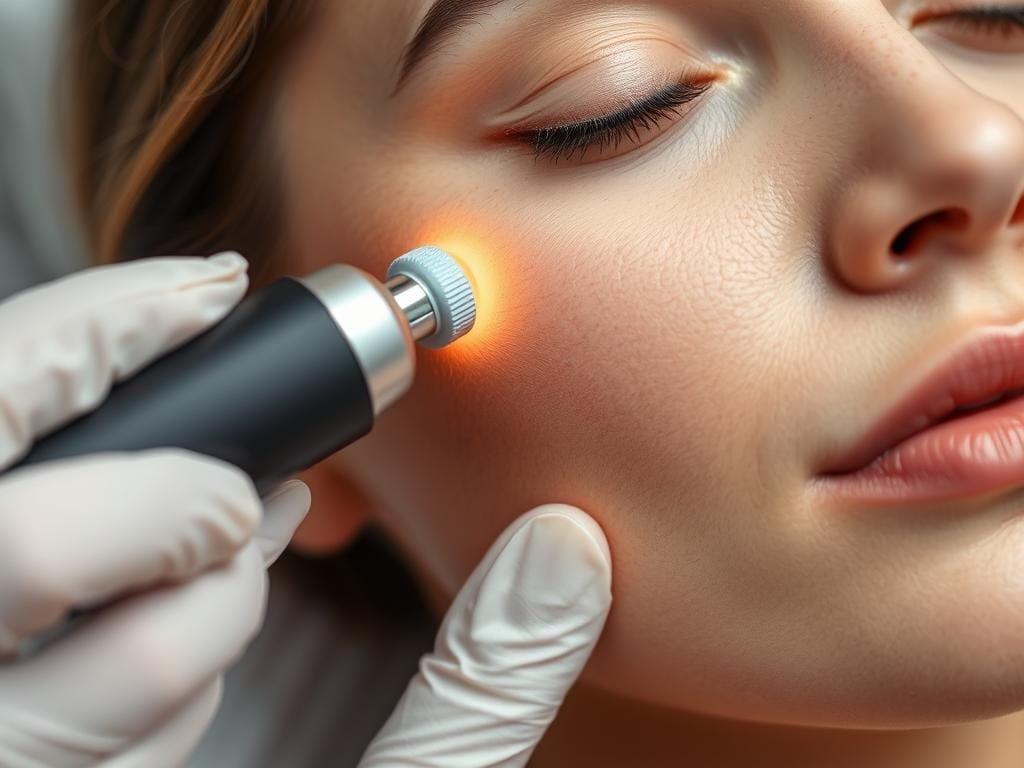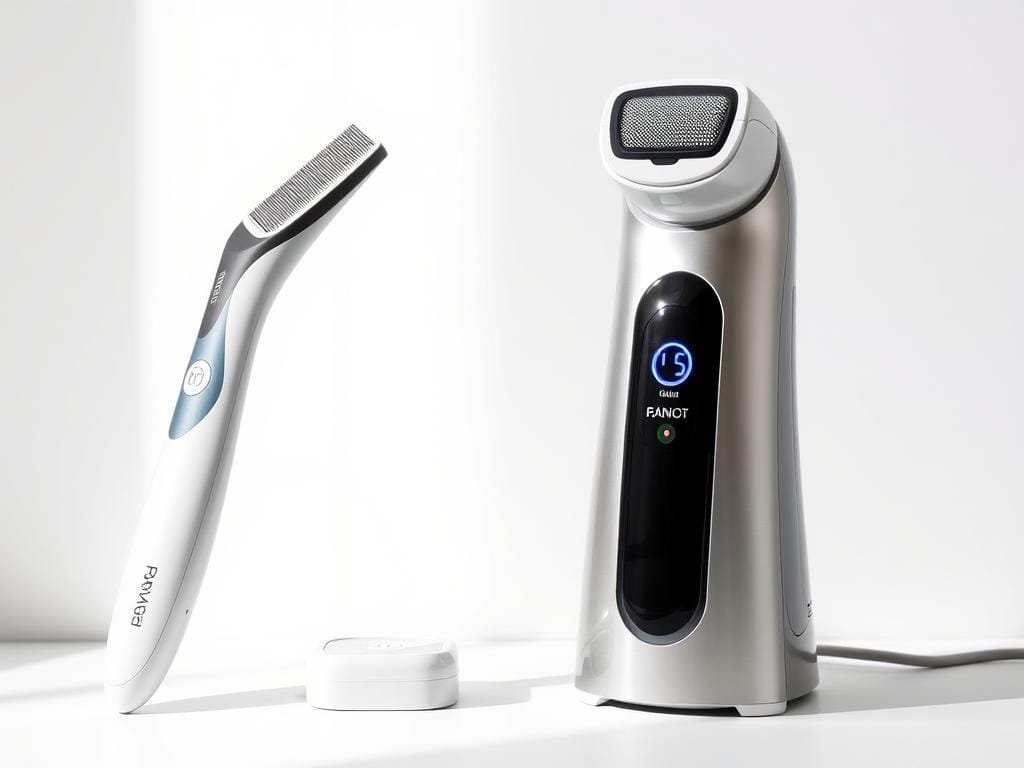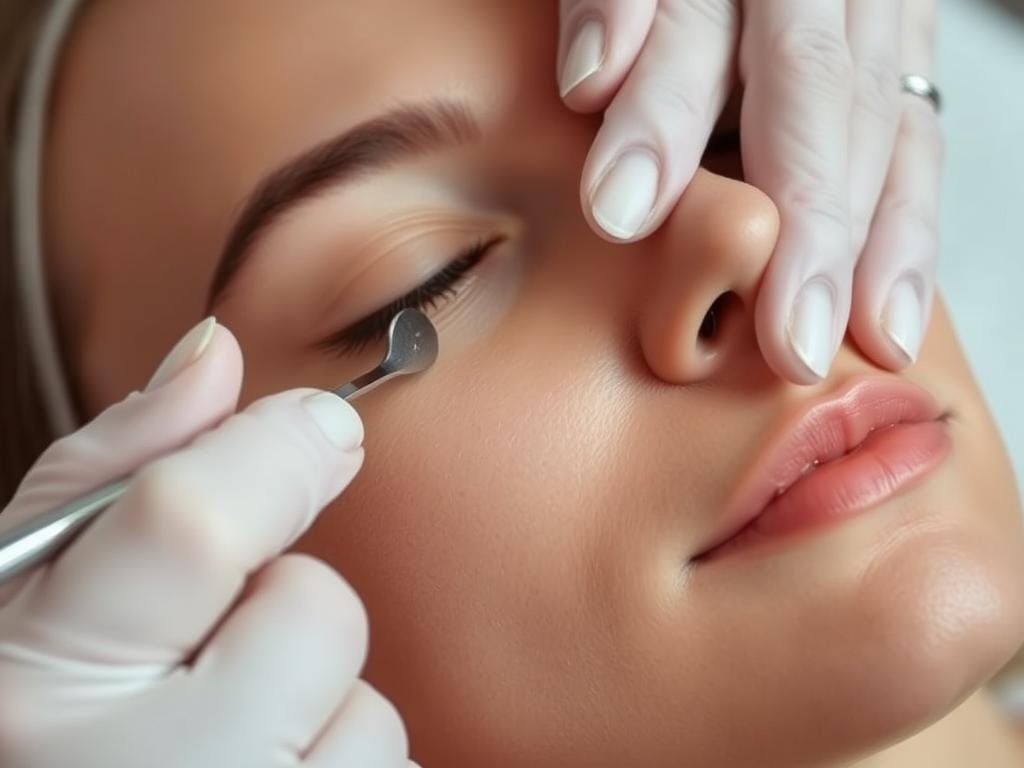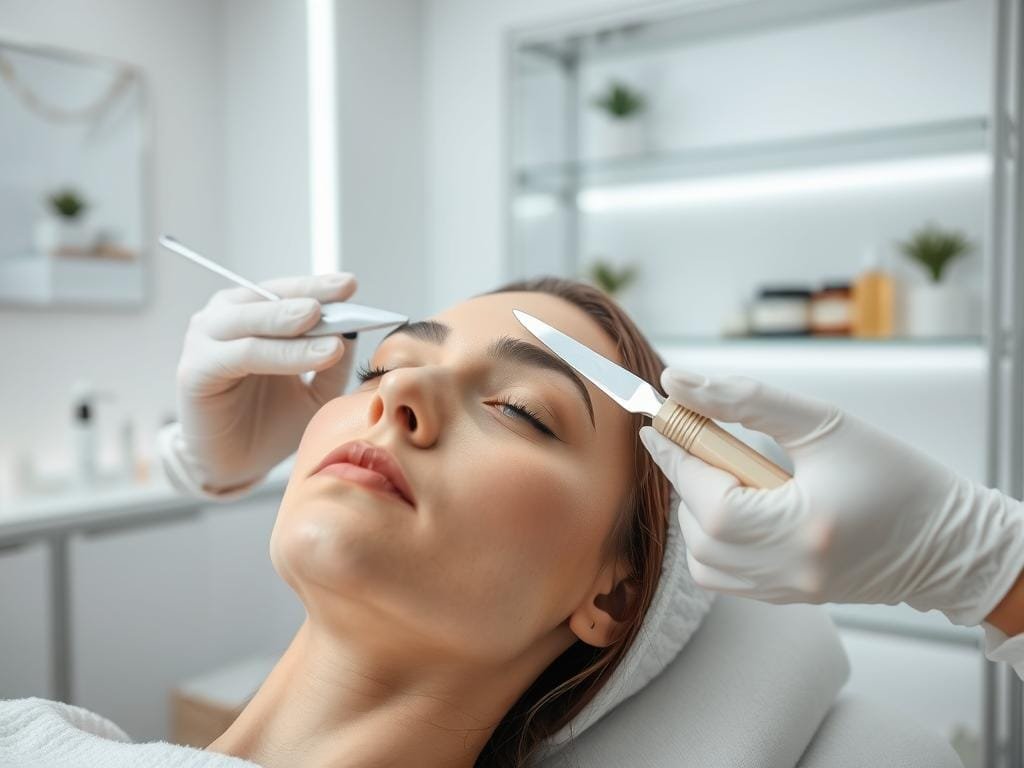Exfoliating your skin is a key part of any skincare routine. With many options out there, it can be tough to decide which one to choose. Facial exfoliation removes dead skin cells, making your skin look brighter and smoother. It also helps your skincare products work better.
Did you know that regular exfoliation can stop breakouts by clearing pores? Treatments like Dermaplaning and microdermabrasion are becoming more popular. It’s important to know what each offers to pick the best for your skin.
Table of Contents
Key Takeaways
- Exfoliation is key to achieving smoother, brighter skin.
- Regular exfoliation can help prevent breakouts.
- Different exfoliation treatments offer unique benefits.
- Understanding your skin type is key in choosing the right exfoliation treatment.
- Consulting a professional can help determine the best treatment for your skin.
What is Dermaplaning?
Dermaplaning is a way to remove dead skin cells and fine hairs using a sharp blade. It’s a gentle method that makes your skin feel smooth and look brighter.
Overview of the Procedure
A professional does dermaplaning by using a special tool to remove the top skin layers. It takes about 30 to 60 minutes, depending on the area.
The practitioner holds your skin tight and uses soft strokes to remove dead skin and fine hairs. This makes your skin smoother and look better.
Benefits of Dermaplaning
Dermaplaning offers many benefits. Some of the main advantages are:
- Smoother Skin: It makes your skin feel smooth.
- Brighter Complexion: It reveals a brighter, more radiant skin.
- Reduced Appearance of Fine Lines: It helps reduce fine lines and wrinkles.
- Improved Product Absorption: It lets your skin care products work better by removing dead skin cells.
Ideal Candidates
Most skin types can get dermaplaning, even sensitive skin. But, it’s not for those with active acne. It’s best for people who want smoother, brighter skin.
If you’re thinking about dermaplaning, talk to a professional first. They can check your skin and give advice based on your type and concerns.
What is Microdermabrasion?
Microdermabrasion is a skincare treatment that’s popular for its skin-rejuvenating effects. It’s a non-surgical method that gently removes the top layer of dead skin cells. This reveals the beauty underneath.

Overview of the Procedure
The microdermabrasion procedure uses fine crystals to exfoliate the skin. It removes dead skin cells and promotes cell turnover. This improves skin texture and appearance, making it a favorite for those wanting to boost their skincare routine.
During the treatment, a device gently blows fine crystals onto the skin. These crystals are then suctioned off, taking dead skin cells with them. This non-invasive technique is quick and painless, perfect for those with busy lives.
Benefits of Microdermabrasion
Microdermabrasion offers several benefits for the skin. It improves texture and reduces fine lines and wrinkles. It also helps with skin discoloration and hyperpigmentation, leading to a more even-toned complexion.
Key benefits include:
- Smoother skin texture
- Reduced fine lines and wrinkles
- Improved skin clarity
- Enhanced skin tone
Ideal Candidates
Microdermabrasion is suitable for most skin types, making it a versatile treatment option. It’s great for those wanting to improve their skin’s appearance without surgery.
Ideal candidates include those with:
- Dull, tired-looking skin
- Fine lines and wrinkles
- Skin discoloration or hyperpigmentation
- Clogged pores or blackheads
Key Differences Between Dermaplaning and Microdermabrasion
Dermaplaning and microdermabrasion are two popular exfoliating treatments. They both aim to make your skin smoother and brighter. But, knowing their differences is important for choosing the right treatment for your skin.
Technique Comparison
Dermaplaning uses a special tool to remove the top skin layers, including fine hairs. This makes your skin smoother. It’s great for sensitive skin because it’s gentle.
Microdermabrasion, on the other hand, uses fine crystals to exfoliate the skin. You can adjust the treatment based on your skin type and concerns. For more details, check out this detailed comparison.
Skin Types and Concerns
Dermaplaning is good for sensitive skin because it’s gentle. It removes fine hairs and can make fine lines and wrinkles less noticeable. Microdermabrasion works for many skin types but might need more care for sensitive skin. It’s great for improving skin texture and can be tailored to your specific skin concerns.
Recovery and Downtime
Dermaplaning gives you immediate results with little to no downtime. You’ll have smooth skin right after. Microdermabrasion might need some downtime, depending on the treatment’s intensity. Knowing these differences helps you plan your treatment and prepare for recovery.
Cost Comparison
When you’re thinking about dermaplaning or microdermabrasion, cost is key. Prices vary based on where you are, the practitioner’s fees, and how many sessions you need. This helps you find the best value for your skin.
Average Cost of Dermaplaning
Dermaplaning prices can vary, but usually, it’s between $100 to $200 per session. The total cost depends on how many sessions your practitioner suggests. This is usually 3 to 6 treatments, spaced about 4 weeks apart.
Average Cost of Microdermabrasion
Microdermabrasion costs also vary, but it’s usually between $75 to $200 per session. Like dermaplaning, the total cost depends on how many sessions you need. This can change based on your skin type and concerns.
To understand better, here’s a comparison of dermaplaning and microdermabrasion costs:
| Treatment | Average Cost per Session | Typical Number of Sessions | Total Average Cost |
|---|---|---|---|
| Dermaplaning | $100-$200 | 3-6 | $300-$1200 |
| Microdermabrasion | $75-$200 | 3-6 | $225-$1200 |
It’s also worth noting that some spas and clinics offer deals for multiple sessions. This can lower the overall cost. Always ask about promotions when you talk to a practitioner.

At-Home vs. At-Home Treatments
Are you thinking about trying dermaplaning and microdermabrasion at home or going to a professional? Both choices have good and bad points. It’s important to know these before you decide.
At-home dermaplaning kits are out there, but it’s safer to get a pro to do it. A skilled person can avoid cuts and get the best results. Microdermabrasion kits at home are easy to use, but a pro can do a deeper and more controlled exfoliation.
Safety of At-Home Options
At-home kits for dermaplaning and microdermabrasion can be safe if done right. But, there’s a chance of doing it wrong and hurting your skin. Always read the instructions and think about your skin type and any issues you have.
To stay safe, remember these tips:
- Look for products from trusted brands.
- Read and follow the instructions well.
- Be careful and gentle, even more so around sensitive spots.
When to Consult a Professional
If you have sensitive skin or past skin problems, see a pro. They can check your skin and give advice and treatment tailored just for you. This way, you get the best results.
Professional treatments have many advantages, including:
- Custom plans based on your skin and needs.
- Experts who know how to avoid problems.
- Top-notch equipment and products.
Preparing for Your Session
To get the most out of your dermaplaning or microdermabrasion session, follow these tips. Getting ready properly is essential for the best results.
Pre-Treatment Tips
Before your professional dermaplaning or microdermabrasion, prepare your skin. Stay away from too much sun and tanning beds for a week. This keeps your skin safe and ready for the treatment.
Tell your practitioner about any skincare products you’re using. This includes products with retinol or glycolic acid. “Always ask your practitioner for advice on getting your skin ready,” experts say.
Products to Avoid
Some products can mess with your dermaplaning procedure or cause side effects. Don’t use harsh exfoliants like AHAs or BHAs for a few days before. Also, skip products with artificial fragrances or dyes as they can irritate your skin.

Don’t wax, tweeze, or use depilatory creams before your treatment. This helps avoid irritation. By following these tips, you’ll have a smooth and effective treatment.
Post-Treatment Care
To keep your smooth, healthy skin after dermaplaning or microdermabrasion, a good aftercare routine is key. Taking care of your skin after these treatments helps keep it looking great. It ensures your skin stays healthy and bright.
Aftercare for Dermaplaning
Your skin might be more sensitive after dermaplaning. So, use gentle skincare products to avoid irritation. Stay away from harsh chemicals or exfoliants for at least 24 hours. Choose products that hydrate and calm your skin instead.
It’s also important to protect your skin from the sun. Use a broad-spectrum sunscreen with at least SPF 30 every day. This helps prevent hyperpigmentation and keeps your skin smooth.
Aftercare for Microdermabrasion
After microdermabrasion, keep your skincare simple and gentle. Stay out of the sun and use a gentle sunscreen. You might see some redness or dryness; a moisturizer can help with these issues.
Avoid heavy makeup for a day or two after treatment. This lets your skin breathe and fully recover.
By following these aftercare tips, you can enjoy the benefits of your treatment for longer. You’ll keep your skin healthy and smooth.
Frequency of Treatments
To get the most out of dermaplaning and microdermabrasion, knowing how often to get them is key. The right time for these facial exfoliation treatments varies based on your skin needs and goals.

How Often Should You Get Dermaplaning?
Experts say to get dermaplaning every 4 to 6 weeks. This helps remove dead skin and keeps your skin smooth. If you have issues like hyperpigmentation or coarse hair, you might need more frequent visits.
How Often Should You Get Microdermabrasion?
For microdermabrasion, aim for treatments every 2 to 4 weeks. The exact timing depends on your skin type and what you’re trying to fix. For example, if you’re fighting fine lines and wrinkles, regular sessions can boost collagen and enhance your skin’s look.
Talking to a skincare expert is vital to find the right schedule for you. They can craft a plan tailored to your needs. This ensures you get the most from dermaplaning services or microdermabrasion, reaching your skin health goals.
Sticking to a regular treatment plan offers lasting benefits. You’ll see better skin texture and a brighter look.
Potential Risks and Side Effects
Thinking about dermaplaning or microdermabrasion? It’s key to know the possible risks and side effects for a safe treatment. Both are usually safe when done by a pro, but some side effects can happen.
Common Side Effects
Dermaplaning and microdermabrasion might cause redness, irritation, and dry skin. These issues are usually short-lived and go away in a few hours to days. To lessen these risks, follow the after-care tips from your practitioner.
Temporary side effects may include:
- Redness and irritation
- Dryness or tightness of the skin
- Slight swelling
- Increased sensitivity to the sun
When to Seek Medical Advice
Though rare, serious side effects can happen. If you notice any of these, get medical help right away:
- Persistent redness or irritation
- Signs of infection, such as increased redness, swelling, or pus
- Changes in skin pigmentation
- Scarring
To ease your worries, here’s a table on side effects and when to see a doctor.
| Side Effect | Common/Temporary | Seek Medical Advice |
|---|---|---|
| Redness/Irritation | Yes | If persistent |
| Dryness/Tightness | Yes | If severe or persistent |
| Infection | No | Yes, immediately |
| Changes in Pigmentation | No | Yes |
Knowing the risks and side effects of dermaplaning and microdermabrasion helps you prepare for a safe treatment. Always talk to a pro about your skin concerns and any questions you have.
Conclusion: Which Treatment is Right for You?
Choosing between dermaplaning and microdermabrasion depends on your skin concerns, type, and preferences. Think about the main differences between these dermaplaning procedure and microdermabrasion treatments.
Key Considerations
Your skin type, concerns, and goals are key. Dermaplaning works well for most skin types, including sensitive skin. It gives instant glow by removing dead skin cells and peach fuzz.
Seeking Professional Advice
Talking to a professional skincare expert is important. They can help pick the best treatment for you. They’ll look at your skin and suggest the best option for your goals, giving you top-notch skincare advice.

